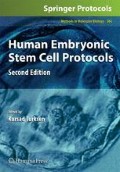Abstract
Human embryonic stem cells (hESCs) have the capacity to self-renew and to differentiate into all components of the embryonic germ layers (ectoderm, mesoderm, endoderm) and subsequently all cell types that comprise human tissues. HESCs can potentially provide an extraordinary source of cells for tissue engineering and great insight into early embryonic development. Much attention has been given to the possibility that hESCs and their derivatives may someday play major roles in the study of the development, disease therapeutics, and repair of injuries to the central and peripheral nervous systems. This tantalizing promise will be realized only when we understand fundamental biological questions about stem cell growth and development into distinct tissue types. In vitro, differentiation of hESCs into neurons proceeds as a multistep process that in many ways recapitulates development of embryonic neurons. We have found in vitro conditions that promote differentiation of stem cells into neuronal precursor or neuronal progenitor cells. Specifically, we have investigated the ability of two federally approved hESC lines, HSF-6 and H7, to form embryonic and mature neuronal cells in culture. Undifferentiated hESCs stain positively for markers of undifferentiated/pluripotent hESCs including surface glycoproteins, SSEA-3 and 4, and transcription factors Oct-3/4 and Nanog. Using reduced numbers of mouse embryonic fibroblasts as feeder substrates, these markers of pluripotency are lost quickly and replaced by primarily neuroglial phenotypes with only a few cells representing other embryonic germ layer types remaining. Within the first 2 weeks of co-culture with reduced MEFs, the undifferentiated hESCs show progression from neuroectodermal to neural stem cell to maturing and migrating neurons to mature neurons in a stepwise fashion that is dependent on both the type of hESCs and the density of MEFs. In this chapter, we provide the methods for culturing pluripotent hESCs and MEFs, differentiating hESCs using reduced density MEFs, and phenotypic analyses of this culture system.
Access this chapter
Tax calculation will be finalised at checkout
Purchases are for personal use only
References
Bliss, T., Guzman, R., Daadi, M., Steinberg, G.K. (2007) Cell transplantation therapy for stroke. Stroke 38, 817–26.
Kondziolka, D., Wechsler, L. (2008) Stroke repair with cell transplantation: neuronal cells, neuroprogenitor cells, and stem cells. Neurosurg Focus 24, E13.
Bambakidis, N.C., Butler, J., Horn, E.M., Wang, X., Preul, M.C., Theodore, N., Spetzler, R.F., Sonntag, V.K. (2008) Stem cell biology and its therapeutic applications in the setting of spinal cord injury. Neurosurg Focus 24, E20.
Coutts, M., Keirstead, H.S. (2008) Stem cells for the treatment of spinal cord injury. Exp Neurol 209, 368–77.
Fitzgerald, J., Fawcett, J. (2007) Repair in the central nervous system. J Bone Joint Surg Br 89, 1413–20.
Takeuchi, H., Natsume, A., Wakabayashi, T., Aoshima, C., Shimato, S., Ito, M., Ishii, J., Maeda, Y., Hara, M., Kim, S.U., Yoshida, J. (2007) Intravenously transplanted human neural stem cells migrate to the injured spinal cord in adult mice in an SDF-1- and HGF-dependent manner. Neurosci Lett 426, 69–74.
Gershon, M.D. (2007) Transplanting the enteric nervous system: a step closer to treatment for aganglionosis. Gut 56, 459–61.
Bjorklund, A., Dunnett, S.B., Brundin, P., Stoessl, A.J., Freed, C.R., Breeze, R.E., Levivier, M., Peschanski, M., Studer, L., Barker, R. (2003) Neural transplantation for the treatment of Parkinson's disease. Lancet Neurol 2, 437–45.
Dass, B., Olanow, C.W., Kordower, J.H. (2006) Gene transfer of trophic factors and stem cell grafting as treatments for Parkinson's disease. Neurology 66, S89–103.
Newman, M.B., Bakay, R.A. (2008) Therapeutic potentials of human embryonic stem cells in Parkinson's disease. Neurotherapeutics 5, 237–51.
Takahashi, J. (2006) Stem cell therapy for Parkinson's disease. Ernst Schering Res Found Workshop, 229–44.
Yang, D., Zhang, Z.J., Oldenburg, M., Ayala, M., Zhang, S.C. (2008) Human embryonic stem cell-derived dopaminergic neurons reverse functional deficit in parkinsonian rats. Stem Cells 26, 55–63.
Heese, K., Low, J.W., Inoue, N. (2006) Nerve growth factor, neural stem cells and Alzheimer's disease. Neurosignals 15, 1–12.
Baharvand, H., Mehrjardi, N.Z., Hatami, M., Kiani, S., Rao, M., Haghighi, M.M. (2007) Neural differentiation from human embryonic stem cells in a defined adherent culture condition. Int J Dev Biol 51, 371–8.
Dottori, M., Pera, M.F. (2008) Neural differentiation of human embryonic stem cells. Methods Mol Biol 438, 19–30.
Nat, R., Hovatta, O. (2004) In vitro neural differentiation of human embryonic stem cells. J Cell Mol Med 8, 570–1.
Nat, R., Nilbratt, M., Narkilahti, S., Winblad, B., Hovatta, O., Nordberg, A. (2007) Neurogenic neuroepithelial and radial glial cells generated from six human embryonic stem cell lines in serum-free suspension and adherent cultures. Glia 55, 385–99.
Zhou, J.M., Chu, J.X., Chen, X.J. (2008) An improved protocol that induces human embryonic stem cells to differentiate into neural cells in vitro. Cell Biol Int 32, 80–5.
Heng, B.C., Liu, H., Cao, T. (2004) Feeder cell density – a key parameter in human embryonic stem cell culture. In Vitro Cell Dev Biol Anim 40, 255–7.
Ozolek, J.A., Jane, E.P., Krowsoski, L., Sammak, P.J. (2007) Human embryonic stem cells (HSF-6) show greater proliferation and apoptoses when grown on glioblastoma cells than mouse embryonic fibroblasts at day 19 in culture: comparison of proliferation, survival, and neural differentiation on two different feeder cell types. Stem Cells Dev 16, 403–12.
Author information
Authors and Affiliations
Editor information
Editors and Affiliations
Rights and permissions
Copyright information
© 2009 Humana Press, a part of Springer Science+Business Media, LLC 2006
About this protocol
Cite this protocol
Ozolek, J.A. et al. (2009). In Vitro Neural Differentiation of Human Embryonic Stem Cells Using a Low-Density Mouse Embryonic Fibroblast Feeder Protocol. In: Turksen, K. (eds) Human Embryonic Stem Cell Protocols. Methods in Molecular Biology, vol 584. Humana Press. https://doi.org/10.1007/978-1-60761-369-5_4
Download citation
DOI: https://doi.org/10.1007/978-1-60761-369-5_4
Published:
Publisher Name: Humana Press
Print ISBN: 978-1-60761-368-8
Online ISBN: 978-1-60761-369-5
eBook Packages: Springer Protocols

